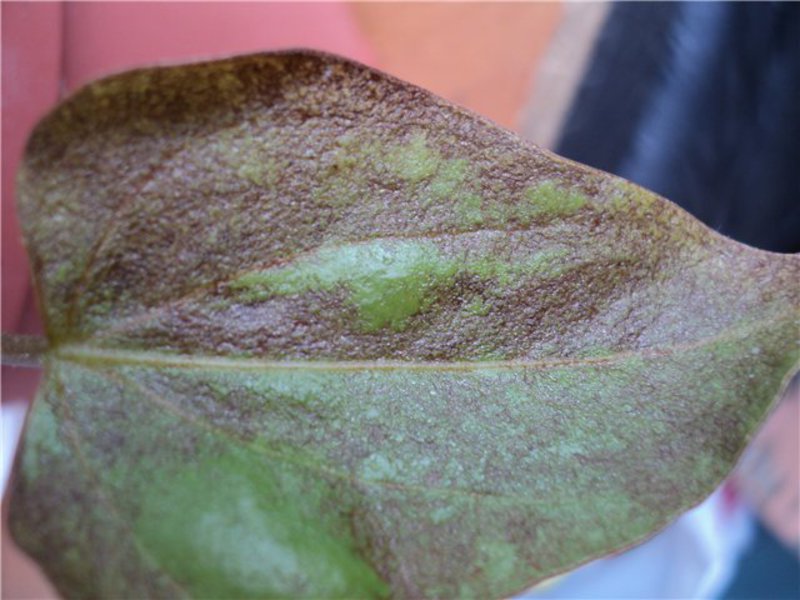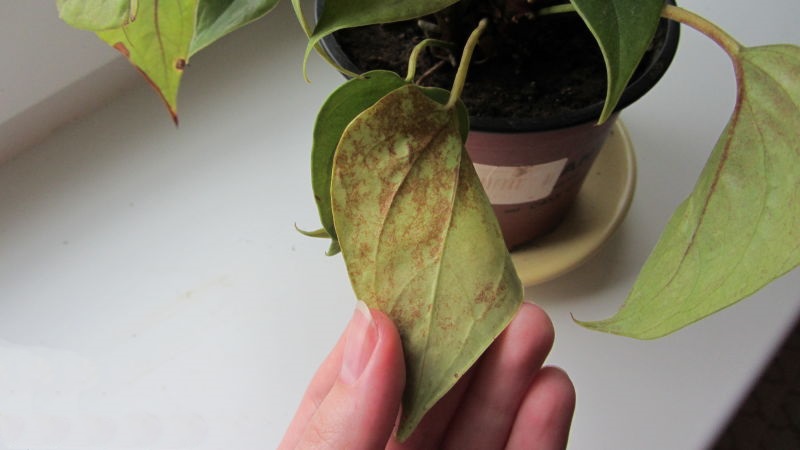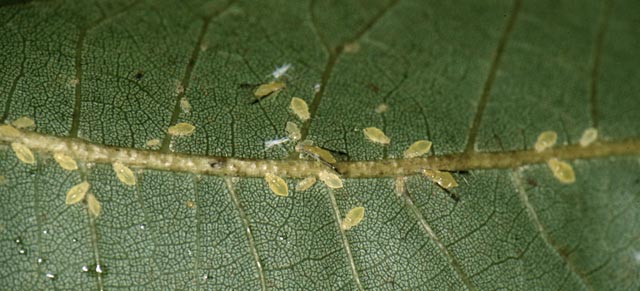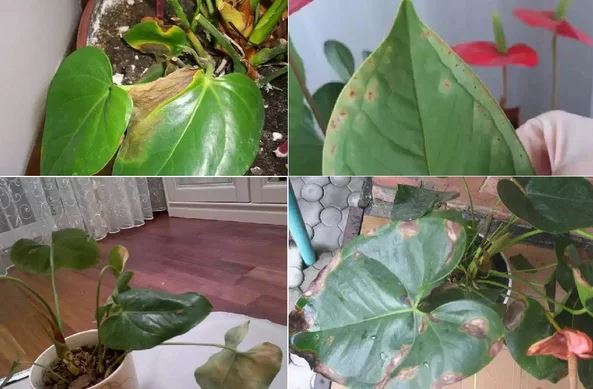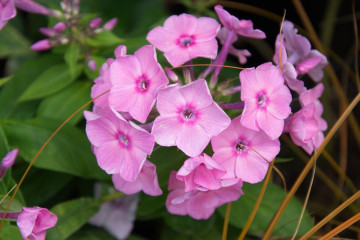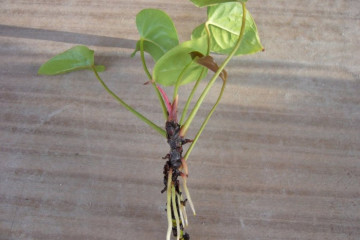Diseases of Anthurium, Anthurium does not grow - what to do?
Content:
Distinguish between fungal, viral and non-infectious diseases of anthurium, which affect the plant with improper care or infection through water, soil, insects. The overwhelming majority of diseases can be easily prevented by observing basic rules for caring for a flower. Avoiding fungal infections will allow the correct irrigation regime, viral diseases are carried by pests, it is important to ensure prevention with insecticides. It is very simple to overcome non-infectious diseases of anthurium, it is enough to provide comfortable conditions for keeping the plant.
Causes of anthurium diseases, their treatment
Leaves turn yellow
If during the cultivation of anthurium the leaves turn yellow what to do, many owners do not know, however, the reasons for the troubles are obvious: often the problem is caused by mistakes in care and uncomfortable conditions to which the flower quickly reacts with protest.
Conditions that determine why the tips of leaves and flowers dry in anthuriums:
- irrigation in direct sunlight;
- dim light in the room;
- deficiency of nitrogen bait;
- small flowerpot;
- watering with hard, too cold and not settled water.
Yellow or brown spots on the leaves of a plant often signal diseases that require surgical treatment. Waterlogging of the soil and low air temperature threaten with bacterial and fungal diseases of anthurium leaves:
- fusarium is introduced when the soil is changed;
- chlorosis manifests itself with a lack of iron and magnesium;
- septoria is a consequence of drafts, cold, humidity;
- rot is formed when the air humidity is high, the leaves can turn brown with excessive watering.
Why do leaves and flowers turn black and dry
Blackened anthurium is provoked by the following factors:
- Watering with cold water. The optimum temperature of the liquid used to moisten the culture is 22-26 degrees. The permissible deviation from room temperature is 2-3 degrees.
- Rhizome decay. The solution to the problem of why the leaves of anthuriums turn black should be sought in improper watering. Excess moisture causes blackening and death of the plant.
- Fungus on the roots of anthurium. With insufficient drainage, the flower begins to suffocate and dry out. To prevent the disease, you should loosen the ground and create additional holes in the pot.
- Hard water. Excess calcium negatively affects magnesium and potassium levels. The percentage of capacity of iron, manganese, zinc, boron also decreases. The lack of useful elements makes the anthurium dry out.
- Excess fertilizer. The dosage should be halved or the feeding should be stopped temporarily.
- Moisture deficiency. Symptoms - the leaves began to curl and darken, a change in their usual shape. It is worth paying attention to spraying the crop or placing a pallet with water next to it, providing increased moisture to the plant.
Sticky leaves how to treat
Dense foliage protects "male happiness" from various parasites. But you should not lose your vigilance. When sticky secretions appear on anthurium, brown spots on the leaves, it is important to know what to do in the fight against the scabbard. Usually the pest is removed with cotton swabs, the bush is treated with an actaric solution - for 2.5 liters of water 2 g. In case of minor damage, it is enough to wipe the foliage with soapy water. Also, the flower is treated with "Karbofos" (2%).
Anthurium does not grow
If the anthurium does not grow what to do, the florist determines based on the conditions of the culture, where the main factor is location in an open and well-lit place, without drafts. Often, amateurs make a mistake when planting a flower. The soil is not suitable for the plant, a transplant or drainage is required - additional reasons why anthurium does not grow.
Anthurium fungal diseases, their treatment
Microscopic fungi can remain on the plant when purchased, or appear with abundant watering. Anthurium is a moisture-loving culture, the probability of the spread of bacteria is as high as possible.
Peronosporosis
Leaves of "male happiness" are covered with white, yellowish spots, gray spores are observed on the reverse side. The source of the disease is a microscopic fungus, which is extremely sensitive to humid air. It is easy to cure peronosporosis - it is enough to reduce the air humidity and treat the culture with contact action fungicides (Topaz, Acrobat).
Anthurium rust treatment
When light spots appear on the upper side of the leaf, and brown pustules on the lower side, it is highly likely that the anthurium began to suffer from a fungal infection such as rust. At the bottom of the leaves, spores develop quickly enough, the spots merge together, the leaves dry out. Fungicides (Albit, Alirin, Fitosporin) are used to treat the disease.
Fusarium wilting
Fusarium is transmitted in many ways, including water and air. New spores of the fungus can grow during temperature extremes and chemical attack. Fungal wilting of anthurium gives out a light pink bloom on the root collar, wilting of leaves. The main measure of the fight against fusarium is prevention, for example, feeding the soil with the antifungal drug "Glyokladina". Systemic pesticides "Vitaros", "Rovral", "Fundazol" are also well recommended in the fight against fusarium.
Septoria
Fungal mycosis appears on the leaves with red spots circled with yellow lines. The leaves begin to wither gradually, and the plant dies. The main method of treatment is the treatment of the culture with copper-containing fungicides (Bordeaux mixture, copper sulfate, "Cuproxat").
Anthracnose
Fungal disease leads to thinning and drying out of the leaves. Dry brown spots appear at the edges or in the middle of the leaf blades. Systemic fungicides (Fundazol, Acrobat, Ridomil Gold) will help in the fight against anthracnose. The spores of the fungus are quite tenacious, if the anthurium could not be saved, you should treat the neighboring plants with pesticides, ignite the old pot and grow a new individual in a safe environment.
Late blight
Symptoms of the disease are the appearance of purple-brown spots on the leaves, their rapid development on the plant and root damage.To destroy late blight, systemic fungicides are used, including Fitosporin-M, Fundazol, Alirin-B, Previkur. You will definitely have to replace the soil, immerse the roots in clean water, rinse and burn the pot. The root system is also treated with a weak solution of potassium permanganate.
Pests
Indoor anthurium, in addition to diseases, can dry out or rot under the influence of insects: aphids, thrips, spider mites, scale insects or whiteflies. When pests appear, a soap solution or insecticide will be required; the culture will have to be processed every 2-3 days.
Aphid
It is easy to recognize the defeat of anthurium by aphids by yellow, twisted leaves, sticky secretions, the plant begins to die quickly. The simplest pest control measure is a warm shower or spraying the plant with soapy water (20 g of laundry soap per 6 liters of warm water). A more effective solution will be the use of drugs: "Antitlin", "Aktara", "Actellik".
Thrips
Leaves affected by thrips are covered with light yellow spots of various parameters and shapes. The parasites are located at the bottom of the leaves and are characterized by a brown tint. The threat of thrips is achieved by the spread of the rust virus. The optimal environment for unwanted guests is high humidity and temperature. It is necessary to adjust the indoor climate. To treat a flower affected by thrips, drugs of high toxicity will help: Tanrek, Actellik or Fufanon.
Spider mite
Spider mites give out small yellow specks on the outside of the leaves, merging into huge spots. A cobweb full of small insects appears at the bottom of the leaf. Mites love heat and dry air. As soon as the flower turns yellow, it is important to urgently treat the leaves with soapy water, remove insects and wipe with mineral oil. Adjust the humidity and temperature regime.
Shield
Whitish or golden brown tubercles on the leaves of anthurium are the first signs of a scale insect that sucks out the life juices of a home flower. An ordinary needle will allow you to remove the pest from the sheet. Single individuals are also brushed off with a toothbrush, wiped with a cotton swab soaked in kerosene - under the kerosene film, the shield will suffocate.
Whitefly
The flower looks depressed, leaves curl and discolor, buds and flowers fall off. It is worth carefully examining the pet, especially the underside of the leaves. Perhaps the plant has become a haven for insect pests - whiteflies. Small moths with many larvae suck out the vital juices of the anthurium. The whitefly discharge on the upper part of the leaf resembles a sticky shiny bloom, similar to sugary streaks, in consistency. When a whitefly appears, experts advise to resort to the use of chemicals: Aktara, Confidor, Akarin, Iskra, Fitoverm, Aktellik, Tanrek.
Non-communicable diseases
Chlorosis
If yellow spots are visible on green foliage in bright light, the culture suffers from poor nutrition (lack of magnesium and iron). It is important to take care of regular fertilizing of the plant with fertilizers for decorative flowers.
Smallpox
Yellow-green bumps and annular yellowing are the result of low temperatures combined with high humidity. If you forget about the regular feeding of anthurium, the plant will not have the strength to resist smallpox, it will take a long time to revive the culture.
Enaties
When a flower is ill with enatsia, an uneven curvature of the leaves, an ugly and humpbacked appearance are visible, the anthurium can turn black.The disease progresses in cold rooms with drafts, sudden changes in dry, humid air.
How to save anthurium if there is a stump with leaves
Luxurious anthurium crushed, rotted, and left a stump with leaves? We will have to use a radical method of preserving the culture: completely cut off the stems, leaves and flowers, remove the anthurium from the soil, carefully examine the rhizome for rotting, clean or cut, treat with an anti-parasite agent. Transplant into a healthy soil mixture.
Anthurium is a beautiful and unpretentious exotic culture. When keeping a plant at home, it is worthwhile to establish proper care and prevention of diseases. The flower will decorate the interior for over 10 years.

